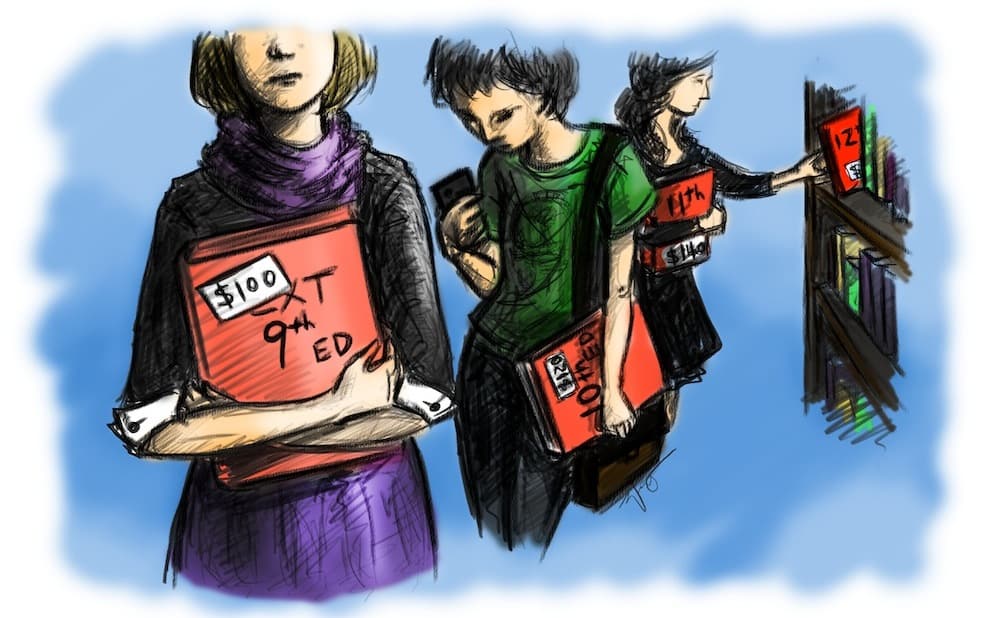The cost of textbooks has been a matter of contention for students and faculty for years, especially amidst rising tuition costs in recent years. The Varsity spoke with a number of students and administration members to discuss their takes on textbook prices and less expensive alternatives.
In an interview with The Varsity, biochemistry professor Laurence Moran stated that claims that course material is too expensive are unfounded. “Students seem to think that these publishers are making enormous profits, and that the prices of books are arbitrarily priced. Publishers are in financial difficulty. They’re actually struggling,” he said. Moran helped write Principles of Biochemistry, the book that has been used in his course for the past 20 years; in 20 years, seven revised editions have been released. Moran emphasized the importance of being cognizant of all of the people behind the process of textbook publication, as well as manufacturing and distribution costs. “You go to the bookstore. All of the students that are in there working have to get paid. All of the deliverymen who brought those books to the store have to be paid. The rent has to be paid. All of that factors in, and publishers never see any of that. It is a complicated story,” he said.
John Challice, vice-president of Oxford Publishing, agreed: “I reject the notion that they’re expensive. Let’s use a $120 textbook as an example. Over the course of 30 weeks, that textbook works out to only $4 a week, which approximately amounts to the cost of one Starbucks latte. Textbooks are an important investment: they help you get a better grade, do better on your exams, and ultimately do better in life,” he said.
Moran recently attended an Ontario Ministry of Education conference centred around how to instill a love of learning in today’s students. “It really resonated with me, and led me to thinking: why would you ever give up your textbook? I still have all of my textbooks from university, and I still look at them from time to time. I loved them when I was taking the course then, and I still love them now.”
However, for some students, the privilege of having a textbook in front of you takes a back seat to the cost. “My stats book costs $200 alone,” said Annapurna Kocherlakota, a third-year public health student. Some students expressed their desire for greater availability of online textbooks. “I haven’t had access to any of my books in that format, but my friends at other schools have, and they say it’s really convenient and much cheaper,” said Kocherlakota. The choice between using printed textbooks and having those same books available online is not only a matter of preference, but one of availability. “I do like online textbooks because they save a lot of money, and that way I don’t have to carry a big textbook around. Unfortunately, not that many courses give this option,” said Miruna Chitoi, a third-year european studies student.
Moran, however, is skeptical about the reception that electronic textbooks would receive from students. “There doesn’t seem to be that intermediate market that would really like to have an electronic version,” he said. Challice emphasized that: “it’s hard to replicate the experience of having a textbook with online content. You can’t replicate having a textbook in front of you with a Kindle.”
Professor Avi Cohen teaches economics at U of T and York University, and has helped co-write the textbook for his course, as well as publish eight editions of study guides for economics. His textbook is bundled with the online resource MyEconLab, where students complete online quizzes for 15 per cent of their final grade. While Cohen admits that a student could successfully take the course relying solely on this e-resource, he states that the cost of losing the educational support that a textbook gives is much higher than the cost of the book itself.
Some professors choose to have electronic or hardcover copies of their textbooks available at select libraries on campus, a lesser-known textbook alternative for students. Perry Hall, supervisor of Information Services at Robarts Library, says that use of hard copy reserves has slowed in recent years. The library has recently started making select academic articles available to students on Blackboard, a much more popular option. As of yet, there is no standard for course reserves, and it is entirely up to the professor to decide whether or not to offer that service to his or her students. The ratio of students to course reserve textbooks can be disproportionately large, with some classes of 1,000 students having only one or two textbooks available on reserve, if at all.


